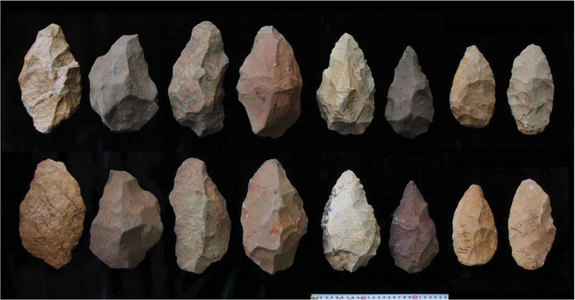Different people study the human past, distinguished by the kinds of evidence they use.
-
Archeologists study things humans have made and the ways they have changed the environment
-
Paleontologists study old bones, pollen, and other biological material
-
Geneticists look for clues about human migration, diet, and more in our DNA
-
Linguists study migration, interactions between cultures and more through the development of language
-
Historians rely on text to study the human past
-
This usually means the written word, but can also include art, music and more
-
This also means that most of the human past is not studied directly by historians, because while modern humans (Homo sapiens) are at least 200,000 years old, writing is only about 5500 years old.
-
Many characteristics thought unique to humans are shared with other species
-
Tool use
-
Many examples of primates using wood and stone hand tools
-
Some birds also use simple tools
-
Tool using birds and primates will also shape tools to their needs
-
-
Language
-
Many animals have large numbers of complex calls
-
Some trained parrots, gorillas, and chimpanzees seem to grasp rudiments of human language
-
-
Thought
-
The apes in general seem to share a similar set of emotional responses to that of humans
-
Abstract reasoning for apes and some birds seems to be similar to human children of roughly 3 to six years old
-
Tracing the development of the human species (explore the entire site)
-
Genetics suggests last common ancestor of humans and chimpanzees may have lived as recently as 6 million years ago
-
First major development was probably bipedal walking
-
Emerged at least by 3 million years ago with Australopithecus afarensis; new evidence suggest much earlier
-
The famed "Lucy" skeleton belongs to this species - may also have been a tool user
-
-
Earliest known tools (2.6 million years ago) predate earliest known Homo habilis, c. 2.4 million years ago
-
With the species Homo erectus, we find hominids widespread by 1.5 million years ago, with a complex tool kit. (The tools shown here are 1.7 million years old, which means they may not be from Homo erectus)

-
800,000 years ago, hominids termed Homo ergaster were burying their dead
-
Multiple hominid species seem to have existed at the same time, and there were many regional variations
-
At least three other hominids are known to have been contemporary to emergence of Homo sapiens
-
Homo neanderthalis (c. 400,000-30,000 years ago)
-
lived in Middle East and Europe, well adapted to ice age conditions
-
extensive tool use, buried dead, possible of evidence of religious behavior
-
-
Homo denisovia - Central Asia and Siberia, roughly same time period as Neanderthals. Similar lifestyle.
-
Genetic research now shows that ancient Homo sapiens interbred with both Neanderthals and Denisovians, and modern Homo sapiens carry small mounts of genetic material from these species.
-
Homo florensis - very small statured hominids who died out in Indonesia c. 18,000 years ago
-
One of the newest finds is Homo naledi
-
Discovered in 2013 in the Rising Star cave in South Africa
-
Age uncertain - species may be 2.5 million years old or more, but the bones in Rising Star may be much younger
-
The bones were found in a cavern that could only be reached through a seven-inch wide chamber. This is highly suggestive they were deliberately placed, potentially pushing back the practice of burial much farther than previously thought. To excavate the cave, a call went out for experienced cavers with a paleontology or related background, and who could fit through such a narrow space. The people who qualified were all young women.

-
Here is the scientific paper that announced the discovery
-
-
-
Homo sapiens
-
Genetics suggest modern humans emerge 250,000 to 200,000 years ago, most likely in East Africa
-
Super volcano Toba explodes c. 70,000 years ago - may have reduced human population to around 5000 breeding pairs
-
As a result, modern humans have very little genetic diversity - much less than most other species.
-
This disaster was followed by a new wave of migrations out from Africa
-
Ice Age Paleolithic culture (c.250,000-c.12,000 BCE)
-
All humans live as hunter gathers
-
Affluence of a kind - seem to have been well fed, low levels of disease
-
Gathering and scavenging at first; hunting culture develops over time
-
Highly expressive art (especially after c.35,000 BCE) suggests high development of language. Chauvet Cave in southern France holds oldest known figurative art.

-
Religious items suggest shamanism (also known as animism)
-
Nature-based religions that see the entire world animated by spirits
-
Ritual and sacrifice use to appease these spirits and to gain their favor
-
Religious specialists called shamans conducted rituals, preserved religious knowledge
-